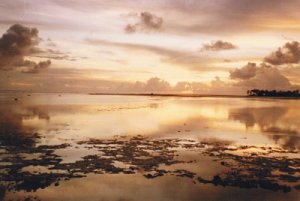Blog
From Doha to Kiribati
14 December 2012
First published by Jesuit Publications on the webpage Eureka Street
 I’ve been to Kiribati (formerly the Gilbert Islands), so I understand its vulnerability. Situated in the central Pacific Ocean and straddling the equator, the sea is everywhere. You’re never more than one or two metres above the ocean on the long, narrow strips of coral atoll that make up a country with a total land-mass of just 811 square kilometres. The significance of Kiribati is that, together with Tuvalu, it will be the first country to be drowned by global warming. The 102,000 people of Kiribati can only retreat into the lagoon or the ocean.
I’ve been to Kiribati (formerly the Gilbert Islands), so I understand its vulnerability. Situated in the central Pacific Ocean and straddling the equator, the sea is everywhere. You’re never more than one or two metres above the ocean on the long, narrow strips of coral atoll that make up a country with a total land-mass of just 811 square kilometres. The significance of Kiribati is that, together with Tuvalu, it will be the first country to be drowned by global warming. The 102,000 people of Kiribati can only retreat into the lagoon or the ocean.
Already the islands are badly eroded and unprecedented long and severe droughts are affecting fresh water supplies and the vegetation on which people depend for food. Wind directions have changed and unseasonal and more violent storms are lashing the twenty-one inhabited islands. It may be that it is already too late for this unique culture, and the Kiribati government has begun negotiations with Fiji to purchase land to re-settle people. Given that last year Australia took 170,000 immigrants from all over the world I find it extraordinary that we are doing precious little for our Pacific neighbours in Kiribati who share much with us culturally and religiously. The islands are 55% Catholic, 38% Protestant and 3% Mormon. With our vast land mass (much of it in the tropics) we could give the entire population a place to live and not even exceed one year’s intake of immigrants, most of whom are simply looking for a better life-style and to whom we have little or no obligation, unlike our Pacific neighbours in real trouble.
Geographically it’s a long way from Doha to Tarawa, the Kiribati capital, but it’s even further in terms of understanding the effects of global warming. Sure, at the recent Doha conference the rich nations pledged funds to repair loss and damage from climate change in poor countries.
But even though there has been recognition of the impact of global carbon emissions on poor countries like Kiribati, there is no legal framework to guarantee compensation and high polluting countries are still unwilling to tackle their own emissions. For instance Australia’s reductions are derisively small while we remain one of the world’s largest exporters of coal, a prime source for greenhouse gases. As the Seychelles representative Ronald Jumeau bluntly told delegates, “If we had more ambition [on emission cuts from rich countries], we would not have to ask for so much money for adaptation ... What’s next? Loss of our islands?” That is precisely what it means for Kiribati. And the Seychelles face a similar threat.
Nevertheless, despite fierce opposition from the United States, the agreement on compensation was recognised as a step forward, even though it stopped short of any admission of legal liability on the part of the developed world and developing world polluters. It was proposed that a fund of $100 billion annually be set up to help poor nations deal with climate change disasters. Where would these funds come from? Perhaps from existing aid and disaster relief budgets? Climate Change Minister Greg Combet rushed in to assure Australian taxpayers that they would not be exposed to these “loss and damage” provisions, even though most Australians would not object to supporting our Pacific neighbours.
The US still refuses to ratify the Kyoto treaty, so the Doha conference set-up a three year process to negotiate a global climate treaty that would embrace both developed and developing countries cutting their emissions. It is proposed that it be signed in 2015 in Paris coming into effect in 2020. This is going to be a massively difficult process with China, the world’s biggest polluter (much of it from Australian-sourced coal), determined to retain its status as a “developing country” even though its economy by 2020 will be the world’s largest.
Meanwhile, out in the real world, where the International Panel on Climate Change (IPCC) is projecting temperature increases of more than 4°C by 2100, we carry on as though nothing was happening. The IPCC told the Doha conference that “approximately 20% to 30% of species are likely to be at increased risk of extinction” if temperature rises exceed 1.5° to 2.5°C above 1980-1999 temperatures. If the rises exceed 3.4°C “model projections suggest extinctions ranging from 40% to 70% of species assessed around the globe.”
The IPCC continues that “by 2020 between 75 and 200 million people [in Africa] are projected to be exposed to increased water stress ... Agricultural production, including access to food in many African countries is projected to be severely compromised.” Add to that ice sheet melting and sea-level rises in regions like the Ganges delta where some 135 million people live and we have a monumental problem.
While we wring our hands and climate sceptics pretend there is no problem, back in Kiribati people are already in the midst of a climate change disaster.
Care to comment? .